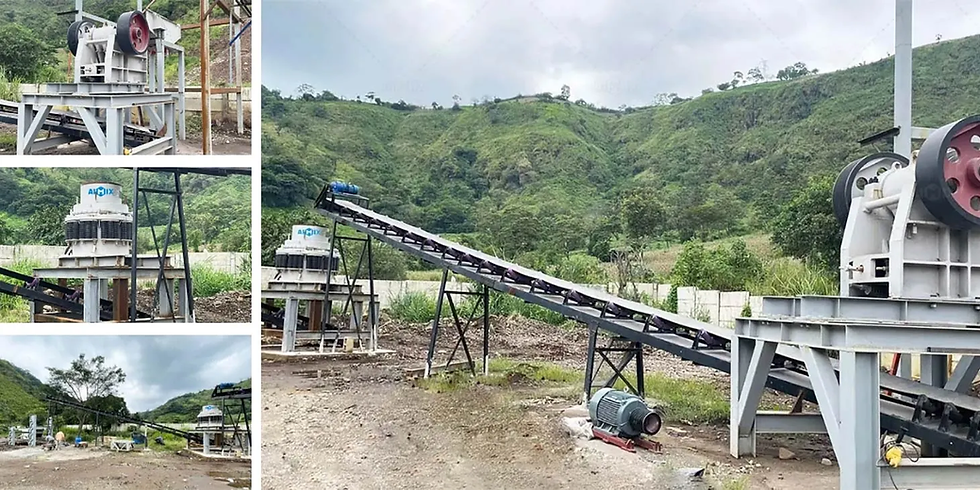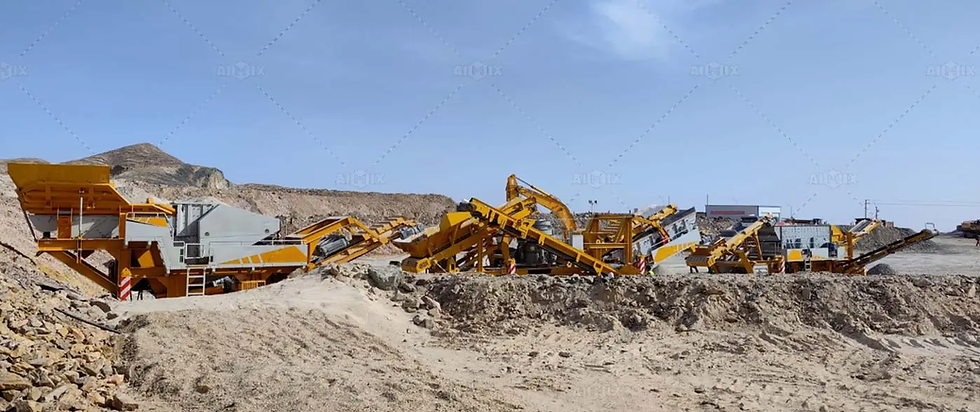Porous Rock Challenges: How Stone Crushing Plants Tackle Sandstone
- aimixgroup china
- May 7
- 3 min read
Stone crushing plants are designed to process a wide range of materials, but handling porous stones like sandstone requires specialized techniques. Unlike dense rock types, sandstone is friable, moisture-absorbent, and prone to crumbling under high impact forces. This unique composition presents challenges in maintaining output quality, reducing dust emissions, and ensuring operational efficiency. Proper stone crusher machine selection and precise adjustments in crushing parameters are essential to prevent excessive material degradation while optimizing production.
Challenges of Crushing Porous Stones
Structural Characteristics of Sandstone and Similar Materials
Sandstone is composed of loosely cemented mineral grains, primarily quartz and feldspar, with varying degrees of porosity. This high porosity makes it susceptible to breakage, water absorption, and inconsistent fragmentation during crushing. Unlike compact rock formations such as granite or basalt, sandstone lacks intrinsic cohesion, leading to uneven particle distribution if not processed correctly.

Additionally, the abrasive nature of quartz grains in sandstone can cause accelerated wear on crusher components, leading to higher maintenance requirements. This necessitates frequent inspection of wear parts to maintain operational efficiency and prolong equipment lifespan.
Risks of Fragmentation and Excessive Dust Generation
Due to its brittle structure, sandstone tends to fracture along natural planes, creating excess fines and airborne dust. Excessive dust generation poses multiple challenges, including worker health risks, environmental concerns, and equipment contamination. Fine particles can also clog screens, affect material grading, and reduce overall product consistency.
If the crushing process is not carefully controlled, sandstone can crumble rather than break into uniform aggregates, leading to wastage and inconsistent product sizing. Ensuring controlled impact forces and optimized crushing sequences is crucial in handling this delicate material.
Optimized Crushing Techniques for Porous Stones
Selecting the Right Crusher Type for Sandstone Processing
To handle porous stones effectively, the choice of crusher is critical. Jaw crushers are often used for primary crushing, as they provide controlled compression forces that prevent excessive fragmentation. However, for secondary processing, impact crushers and cone crushers offer finer control over particle size distribution.
Jaw crushers: Ideal for initial size reduction, minimizing excessive breakage.
Impact crushers: Effective for shaping aggregates but require adjustments to avoid over-fracturing.
Cone crushers: Provide gradual compression crushing, which is advantageous for reducing fines production.
The key is to balance force application to avoid crushing sandstone into dust while ensuring consistent aggregate quality.
Adjusting Operational Parameters to Prevent Excessive Degradation
Fine-tuning crusher settings is essential when working with fragile, porous materials like sandstone. Key adjustments include:
Reducing rotor speed in impact crushers to minimize excessive fines.
Controlling feed rate to ensure even material distribution.
Optimizing crushing chamber design to reduce unwanted attrition.
Using moisture control to prevent airborne dust from escaping the processing line.
Carefully calibrated crushing conditions lead to better aggregate shape, less wastage, and improved process efficiency.

Enhancing Efficiency and Product Quality
Dust Suppression and Moisture Control Strategies
Dust management is a significant concern when processing porous stones. Effective strategies include:
Water sprays and misting systems to suppress airborne particles.
Enclosed conveyor systems to reduce dust escape points.
Vacuum dust collection units for finer particulates.
Incorporating these techniques ensures compliance with environmental regulations, enhances worker safety, and reduces equipment contamination.
Implementing Screening and Grading for Uniform Output
Once sandstone is crushed, efficient screening is required to separate usable aggregates from fines. Key screening strategies include:
Multi-deck vibrating screens for precise grading.
High-frequency screens to minimize moisture-related clogging.
Adjustable mesh sizes to achieve required specifications.
Proper screening ensures that the final product meets strength and durability requirements, making it suitable for construction, roadwork, and specialized industrial applications.
By implementing optimized crushing techniques, proper dust suppression, and efficient screening, a stone crusher plant can process porous stones like sandstone without excessive material loss. This enhances overall efficiency, product quality, and environmental compliance, making it a viable solution for diverse construction demands.



Comments